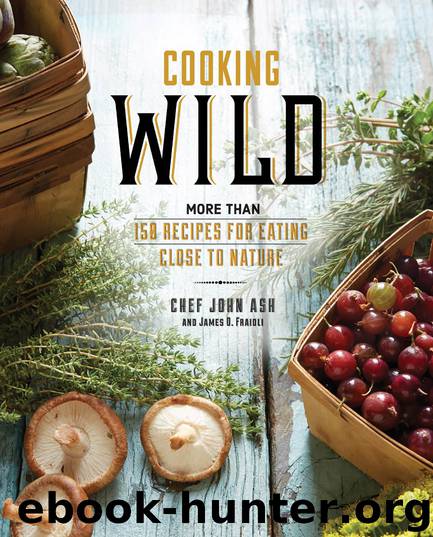Cooking Wild by John Ash

Author:John Ash
Language: eng
Format: epub
ISBN: 9780762458288
Publisher: Running Press
Published: 2016-01-30T05:00:00+00:00
HONEY
HONEY HAS PROBABLY BEEN WITH US FOR AS LONG AS HUMANS HAVE WALKED upright. No doubt, wild honey was gathered in the beginning, as written history traces the sticky substance back to 2100 BC. Beekeeping is illustrated in ten-thousand-year-old cave paintings in Spain and was recorded in a sun temple erected in 2400 BC in Egypt, where honey was a royal symbol and used as an ingredient in embalming.
It’s not surprising that honey was considered a magical food by primitive peoples. It has been used in rituals throughout history, often to make sculptures in the form of a god, which were then consumed in order to ingest the holy aspect of that god.
Although there are many bees that are native to North America, the honeybee is not indigenous to this continent; it was brought here by European settlers and established in the wild by escaping swarms. Honey was the main sweetener in Europe and then in North America up until the discovery of sugarcane and beets, which provided much more abundant and cheaper sweeteners. Though we don’t ordinarily gather honey any longer in the wild, there are some intrepid souls out there who still scout it out. Of course, bears are wonderful foragers of honey.
The honey-making process starts with bees collecting nectar from flower blossoms. They carry it back to their nest, where the worker bees add enzymes and transfer the mixture to honeycombs. The water in the nectar is then evaporated by the action of the bees fluttering their wings (this is the humming you hear inside a hive), which converts the nectar into honey. This substance is a food source for the bees during cold months when flowers are not blooming, but a healthy colony will produce up to three times as much honey as it needs, allowing some to be harvested.
Honey contains about 70 percent fructose and glucose. Honey with a high fructose content will be clear, while the kind with more glucose may crystallize or thicken, but both are a pure food source. To melt crystallized honey, just stand the jar in warm water and it will clear in about an hour. Bees usually have a flight radius of one or two miles, within which they gather nectar from many kinds of flowers (which yields polyfloral honey) or from just one kind (which yields monofloral honey), depending on what is available to them in their gathering territory. The flavor of honey is determined by the type of flower or flowers the nectar comes from, as well as their terroir; the nectar of the same kind of flower will vary depending on where the flower grows. The depth of flavor of a honey can generally be judged by its color, which ranges from very pale in mild honeys to almost black in intensely flavored ones.
Honey has always been valued as a healing substance as well as a food source. Raw honey (see “What Is Raw Honey” below) is both antimicrobial and an antioxidant; historically, it was most commonly applied as a wound dressing.
Download
This site does not store any files on its server. We only index and link to content provided by other sites. Please contact the content providers to delete copyright contents if any and email us, we'll remove relevant links or contents immediately.
The Sprouting Book by Ann Wigmore(3543)
Better Homes and Gardens New Cookbook by Better Homes & Gardens(3525)
Trullo by Tim Siadatan(3379)
Super Food Family Classics by Jamie Oliver(3368)
Hedgerow by John Wright(3275)
Panini by Carlo Middione(3252)
Bread Revolution by Peter Reinhart(3083)
Sauces by James Peterson(3051)
Jam by Jam (epub)(3024)
Ottolenghi - The Cookbook by Yotam Ottolenghi(2871)
Oh She Glows Every Day by Angela Liddon(2729)
My Pantry by Alice Waters(2546)
Hot Sauce Nation by Denver Nicks(2451)
The Culinary Herbal by Susan Belsinger(2431)
Veg by Jamie Oliver(2410)
Wanderlust by Jeff Krasno(2225)
Meathooked by Marta Zaraska(2220)
The Art of Making Gelato by Morgan Morano(2216)
Basic Illustrated Edible and Medicinal Mushrooms by Jim Meuninck(2187)
